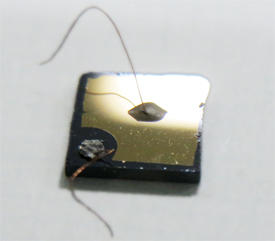

12/21/2015

© 2015 Fumihiro Matsukura
An electric field can fine-tune a crucial property of a ferromagnetic material, AIMR researchers have found. Their approach could be useful in applications such as spintronics, a promising form of low-energy computing that aims to encode data using the spin of electrons.
Spin causes an electron to behave like a miniature bar magnet. Ferromagnetic materials typically contain unpaired electrons whose spins all point in the same direction, so that the whole material becomes magnetic ― or more specifically ferromagnetic.
An external magnetic field can alter the orientation of these spins, with the size of the effect depending partly on the Gilbert damping constant, an intrinsic property of the material. But the factors that determine the damping constant itself are poorly understood.
Fumihiro Matsukura, Lin Chen and Hideo Ohno of the AIMR at Tohoku University have now used an electric field to control the Gilbert damping constant of a semiconductor called gallium manganese arsenide, or (Ga,Mn)As1.
Whereas metals carry electrical current as a flow of electrons, current in (Ga,Mn)As is mostly carried by ‘holes’ — positively charged points in the material where an electron is missing. These holes interact with unpaired electrons on the material’s manganese ions to make the material ferromagnetic.
The researchers fabricated several devices that contained a 4-nanometer-thick film of (Ga,Mn)As on a gallium arsenide substrate, covered with a layer of insulating alumina and a gold–chromium electrode (see image). The devices contained different proportions of gallium and manganese in the ferromagnetic layer.
Subjecting the devices to external magnetic fields at various angles, and under positive and negative voltages, allowed the team to measure how the Gilbert damping constant changed. These ferromagnetic resonance experiments showed that the key factor in determining the damping constant was the hole concentration in the (Ga,Mn)As film.
Areas of (Ga,Mn)As that have a lot of holes are fully ferromagnetic, whereas regions with relatively few holes are much less magnetic. Applying a voltage changes the distribution of holes in (Ga,Mn)As, which affects the balance between these two regions.
“This indicates that the damping constant of (Ga,Mn)As can be modulated electrically,” says Matsukura. This approach could also help to reveal the mechanism that determines the damping constants in other materials, he adds.
“Electric-field effects on magnetism are interesting from a fundamental physics point of view, as well as to explore new functionality in spintronics devices,” he adds. “We hope to use these effects to realize practical devices with low power consumption.”
Chen, L., Matsukura, F. & Ohno, H. Electric-field modulation of damping constant in a ferromagnetic semiconductor (Ga,Mn)As. Physical Review Letters 115, 057204 (2015). | article
This research highlight has been approved by the authors of the original article and all information and data contained within has been provided by said authors.